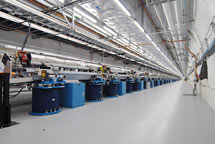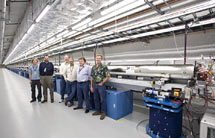
Handy Links
SLAC News Center
SLAC Today
- Subscribe
- Archives: Feb 2006-May 20, 2011
- Archives: May 23, 2011 and later
- Submit Feedback or Story Ideas
- About SLAC Today
SLAC News
Lab News
- Interactions
- Lightsources.org
- ILC NewsLine
- Int'l Science Grid This Week
- Fermilab Today
- Berkeley Lab News
- @brookhaven TODAY
- DOE Pulse
- CERN Courier
- DESY inForm
- US / LHC
SLAC Links
- Emergency
- Safety
- Policy Repository
- Site Entry Form

- Site Maps
- M & O Review
- Computing Status & Calendar
- SLAC Colloquium
- SLACspeak
- SLACspace
- SLAC Logo
- Café Menu
- Flea Market
- Web E-mail
- Marguerite Shuttle
- Discount Commuter Passes
-
Award Reporting Form
- SPIRES
- SciDoc
- Activity Groups
- Library
Stanford
Around the Bay
LCLS Undulators Installed and Ready for Beam
SLAC's linac started up again last Wednesday after three weeks' downtime to install 21 of the 33 undulator magnets that will help generate X-rays in the Linac Coherent Light Source. The LCLS commissioning team completed the installation and initial alignment with impressive speed, taking less than half the time allotted for the work. If all continues to go well, the linac's electron beam could make its first test run through the new undulators as soon as April 4.
Resting on their support girders in the LCLS Undulator Hall, these first 21 magnets make the LCLS the world's longest undulator, at 84 meters (276 feet). By June, the remaining 12 will be added to the Undulator Hall, bringing the total length, including short breaks between magnets, to 132 meters—about the length of a football field plus an extra 24 yards. In order to generate powerful, free-electron light from this string of undulator magnets, the electron beam brightness must meet a set of challenging criteria—the focus of the successful accelerator commissioning up to this point, starting with the new radio-frequency photocathode gun in April 2007. (See "Have Gun, Will Travel (at Light Speed).") In addition, the magnets that guide the beam must be aligned to extraordinary tolerance levels. At its highest performance, the beam must not deviate from a straight line by more than about 5 microns per 5 meters. Much effort has gone into preparing for this primary challenge, from careful initial survey methods in the Undulator Hall through high-precision magnet tuning and creation of a novel beam-based alignment strategy.
Each 3.4-meter undulator magnet includes 224 alternating-polarity permanent magnets made of a neodymium-iron-boron alloy. These high-field magnets will force the linac's 14GeV electron beam to wiggle left-to-right along its path. The "wiggle" is very small, about 0.001 millimeters, but will be responsible for generating the extremely high-power coherent X-rays that make this new machine so revolutionary. The entire LCLS undulator system was designed, fabricated and tested at Argonne National Laboratory by a dedicated group in the lab's Advanced Photon Source division led by Argonne LCLS Project Director Geoff Pile.
At SLAC, each undulator magnet is measured and carefully shimmed to very high precision in SLAC's Magnetic Measurements Facility, led by Zack Wolf. MMF staff ensure that the "wiggle" amplitude is constant to one part in ten-thousand, and the beam trajectory after each magnet deviates by no more than 0.00005 degrees.
This measurement and shimming process requires at least one week of work in the MMF per magnet—but only after the magnet has been stored in the MMF long enough to reach its normal temperature, about 4 days. During measurements in the MMF, the undulator is intentionally set in the exact orientation it will take in the Undulator Hall, so that all measurements and corrections properly include the Earth's magnetic field, which would otherwise divert the electrons off their precise trajectory. Finally, just to be sure, the Earth's field is also attenuated by a wrapper of special "mu metal," a nickel-iron alloy that gives each undulator its shiny outer shell.
In addition to the undulator magnets, the full undulator beamline includes many other critical components that will guide the electron beam through the Undulator Hall. One focusing quadrupole magnet and one cavity-type beam position monitor, or BPM, sits between each pair of undulators. Each of more than 33 BPMs measures the beam position as it passes through. Designed and built by experts from ANL and the SLAC controls group, the BPMs must catch variations in beam position down to less than one-fiftieth the diameter of a human hair. Testing done in January demonstrated the BPMs can meet and even exceed that performance metric.
Once the beam position is captured by the BPMs, adjustment of the powerful quadrupole and undulator magnets can bring the beam into precise alignment. The beam data are automatically fed into a computer and the necessary girder position corrections are calculated and fed back to motors in the Undulator Hall. The entire girder that supports each undulator sits on top of five motorized cams, allowing remote control of position, pitch, yaw and roll angle for each magnet. In addition, two separate motors can move each undulator horizontally, independent of the girder, to effectively switch the magnet off for diagnostic work and adjustments. This horizontal movement also allows small corrections to the "wiggle" amplitude of each undulator, to optimize performance. The elaborate controls for the undulators were designed by the controls groups at ANL and SLAC, with much careful testing during the fall of 2008. Finally, a new beam-based alignment procedure is applied which can straighten the undulator path to a level not yet possible with standard survey techniques. It has already been successfully tested, and is possible due to the exceptional performance of the undulator BPMs.
With such tight tolerances in beam alignment, ground motion and temperature variations can affect beam positioning. To monitor these relatively-slow changes, a precision alignment diagnostics system, designed and built by the SLAC metrology department, will take a two-pronged attack, using stretched wires and hydrostatic levels. The wires reach over a distance of 140 meters, the full length of the 33 undulators. Four sensors at each undulator magnet monitor fields induced by a high-frequency alternating current run along the wire. Each sensor can detect position changes of the girder down to a remarkable level of 0.1 microns. Since gravity causes the wire to sag at its center, and this sag varies slightly with temperature, the vertical measurements require more finesse. To complement the wire system, four half-filled water vessels are stationed at each undulator magnet. Linked together with water piping across the Undulator Hall, the vessels monitor vertical alignment of each girder by sensing any changes in water level.
Installation of these precision diagnostics, focusing components, and now the first 21 undulator magnets allows the LCLS commissioning effort to press to the next and most exciting phase: the production and characterization of free-electron laser light. With the first 21 undulator magnets installed, there should be enough undulator length to generate FEL light at even the shortest X-ray wavelength (1.5 Angstroms), depending on the electron beam quality, trajectory, and magnet tuning—all of which appear to be within grasp. Then, the months of May and June will be spent commissioning the suite of X-ray diagnostics, collimators, mirrors and attenuators, designed and built at Lawrence Livermore National Laboratory, needed to characterize and optimize the FEL light. July of 2009 could see the introduction of X-rays into the Near Experimental Hall, in time to be tuned for the first user experiments in September.
—Paul Emma, Hans-Dieter Nuhn and David Schultz for the LCLS Commissioning Team
SLAC Today, March 30, 2009

